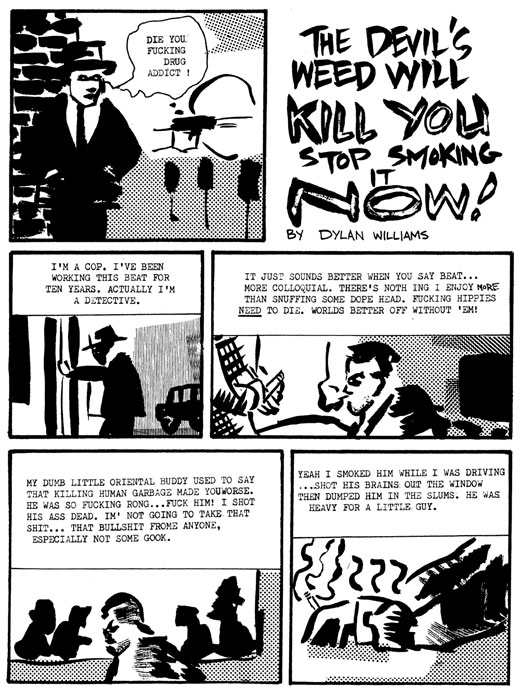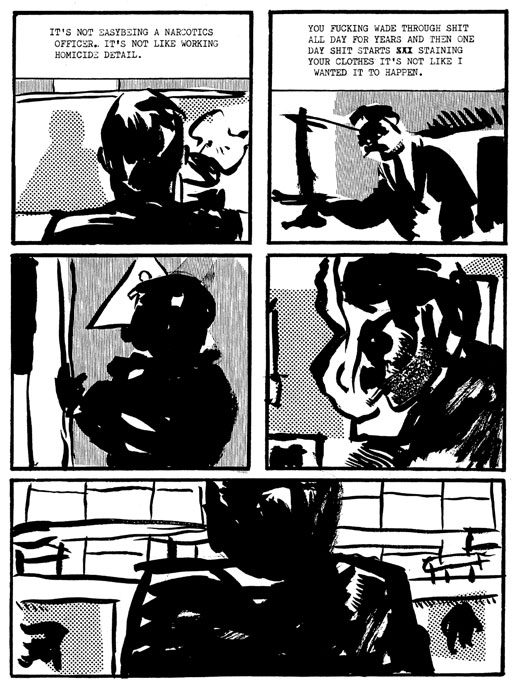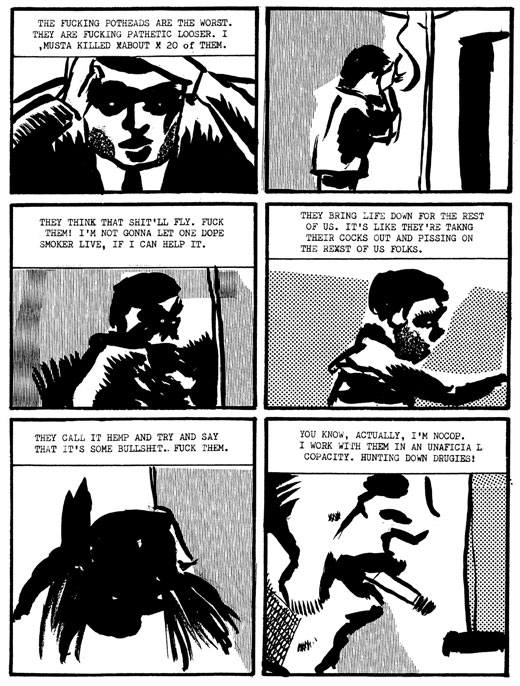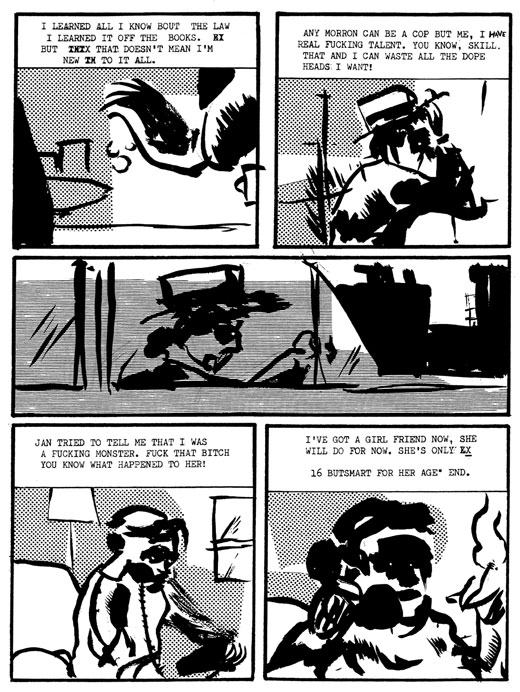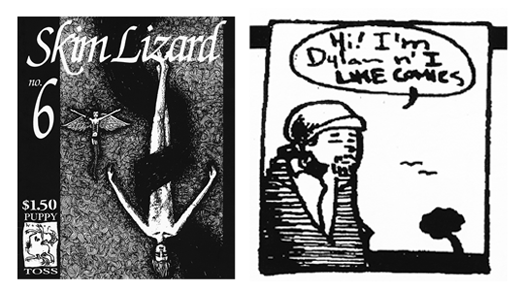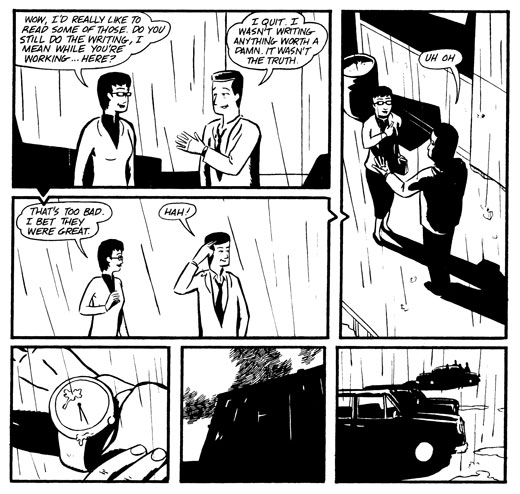[Originally published in issue six of the zine Destroy All Comics]
Puppy Toss is a collective of artists in Berkeley. I rode BART down to their office space on Friday, May 6, 1994, and conducted this interview. Present were Gabby, Scott, Ibar, k, Roy, Barry, Ben, Lisa, Max, Nik, and Dylan.
Jeff: What is Puppy Toss?
k: Puppy Toss is a collective of independent comics artists. We get together and pull our resources, our money, our time, our talent and try to help each other get our work out there. We're basically a company run by artists.
Gabby: (Jokingly) and we're all God-fearing Christians.
Roy: We handle snakes.
Jeff: Is Puppy Toss is a real company?
k: Yeah. We actually have all the business licenses, and if we ever make any money, we'll have to pay taxes and stuff like that.
Scott: This is my department. We're officially formed as a business - a partnership, and it's really open to new people to join the business officially. We're considering going to non-profit status. Maybe, maybe not.
Jeff: What does Puppy Toss do?
k: We do a couple of different things. The main book that we publish, and that Puppy Toss pays for out of its own bank account, pocket, and time, is Skim Lizard. It's an anthology that comes out quasi-monthly, you know, whenever we can put it out. The first issue is a full color cover outside thing with shitty newsprint interiors. After that we decided we needed a change because we didn't want to use that format. So, we switched to doing more the mini size... digest. The philosophy behind the anthology, like our first issue, we had a lot of really good pieces from everyone, but it was kind of weird for me to have one piece that was really dark and disturbing, and then something really cartoony, and then something kind of touching ... and it was too much of a jump. So from issue two on, we try to group pieces together that fit and will complement each other. One issue might have a really somber tone, and another one might... it all varies.
We also do a catalog which Dylan puts together, a newsletter called Forbidden Grampers that Scott does, and generally try to foster a little community here and support.
Scott: I think even though those are the concrete things that we do, that we put out there ... l think going back to the beginning of when we were formed, Skim Lizard was more like a concrete goal to get us to get moving, but for me the most important thing is the creation of the group... the collective. Skim Lizard is just an outgrowth of that. We could chuck all the projects were doing and do something completely different and still be Puppy Toss.
k: A really cool thing is that when I think of Puppy Toss in my mind, I don't think of it as a place, or as someone who publishes. I think of all my friends in Puppy Toss and all the people.
Dylan: Yeah, I think that all our arms are like vehicles to get people to contribute, to get involved and to show people that they can publish themselves or work together.
Jeff: To finish with Skim Lizard, how many issues have been put out?
k: So far we've put out five issues, and the sixth issue is all set for production.
Scott: And you see the stack of artwork in front of you there ... that's coming up issues.
 Jeff: What's the story with the catalog and what's it called?
Jeff: What's the story with the catalog and what's it called?
Dylan: There's no name for the catalog ... it's just the catalog, and the name's going to change every time depending on who does the cover. Basically, it's just a way to put a whole bunch of books together by every possible mini-comic artist that we can find, and zines, and it's even open to records and stuff like that too. It's the theory that together they'll sell each other. There's no exclusionary policy. That's the big point.
Scott: The big point, yeah.
Dylan: We won't turn anything down, basically. You can fart on toilet paper and send it to us.
all: No, don't say that (laughter). You could...
Gabby: We won't buy it and say it's the greatest shit ever, but we'll include it.
Scott: And if in a year from now and we can't even sell one copy, it's not our fault.
k: But if it has a distinctive smell, we'll say that.
Roy: Actually, the last one did have a name, it was named Lester, wasn't it?
Dylan: That was the first one, and this one is called A Catalog.
Scott: I think the greatest thing about the second catalog is that as soon as it was done and Dylan was giving copies to people, they were sitting there and reading it for ten, twenty minutes. It really surprised me, because a catalog is not something you read usually… it's something you flip through and say, oh I want that and order it. It's like a review zine, and all of us did reviews for it. It was neat to see people reading it. It was great!
Gabby: I hope someday it grows to be as entertaining as the Amok catalog... that's one of the greatest catalogs.
Dylan: Except ours is better.
K: Ours is cheaper and free.
(laughter)
Jeff: I liked it a lot, because I found some stuff in there that I'd never seen before, or that I'd vaguely heard of and was wondering, how the hell can I get this.
Scott: That's the great thing about the catalog. Everybody we get in contact with who is a publisher, we say, "Give us five, ten copies. We will see if we can sell it." It's not like were excluding people.
Dylan: And there's even mainstream comic artists in there, like Mitch O'Connell. Anything that's self-published. That's another criteria. I mean, if it's printed by Marvel, we're probably not going to carry it.
(laughter)
K: What would happen if Dave Sim sent us a bunch of Cerebus.
Dylan: We'd probably carry it.
Scott: Carry it and sell no copies, and then it'll go away.
Gabby: We can vote too. If somebody is strongly opposed to something, we can vote about it.
Jeff: How often does your catalog come out?
Dylan: There's no regular schedule. I plan to do updates... because it costs so much many to put it out all at once. We're going to do updates with maybe twenty books in them, or something like that.
Jeff: Have you found that you are getting orders from the catalogs you send out?
Dylan: Oh yeah. A surprising amount of orders. I expected like ten percent or twenty percent returns. There are so many returns, I don't know. Fifty percent, I'd say... if not more. Which is amazing, because with most catalogs you get like ten percent.
k: And we get a lot of people requesting it too.
Scott: I remember the first one that came out...we sent out twenty of them right away, and a few days later, somebody sent us thirty bucks, and I was like doooo.
Dylan: And most people buy more than one thing.
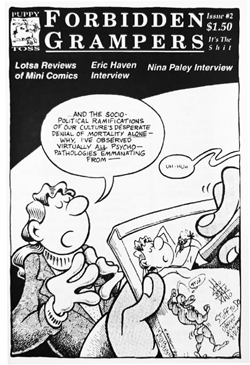 Jeff: Tell me about Forbidden Grampers.
Jeff: Tell me about Forbidden Grampers.
Scott: Originally it was going to be a newsletter for Puppy Toss, and I wanted to do something more, but I don't know where it's going. It could go anywhere.
I'm not sure who: Do you think we should tell him about the name?
Scott: Oh boy. That was like ... l wanted to do Forbidden Grampers, and I sort of jumped in and took over and wanted to make something out of it, but I realized that the strength of Puppy Toss is the group of people. So, to start it off we got together at meetings and tried to come up with a title. It was easy to come up with Puppy Toss and Skim Lizard because we had like four people deciding, but we had like twenty thirty people at meetings.
k: We had the weirdest list of names.
Roy: I think we should have stuck with the animal, verb symbol, like we did with our last two titles.
Dylan: We should have just done a symbol, like Prince. People would have gone "Oh, is the new out."
(laughter)
Scott: So that was a pretty long, involved process, just coming up with the name. I kind of see it as a tool to unify the small press. That's mostly what I'd want to do with it. It comes out whenever I can get it out.
Nik: The ads are really cheap.
Scott: Yeah, the ads are really cheap. Classifieds are free.
Jeff: The third issue is next. What's that going to be?
Scott: I was trying to come out with it in May, but since I'm leaving on a long trip and moving out at the same time, I don't really have time to do it. The next issue is going to have the rest of the Eric Haven interview, a Chris Ware interview ... as soon as Dylan types it up. I think an article on how to start a business, and I think k is going to do something on teaching, and we're going to try to have regular columns for whoever here wants to do it. It has classifieds. I put lists of addresses, and reviews. We're doing reviews now.
Jeff: There was definitely a big improvement from issue one to two.
Scott: Yeah.
Dylan: We had a lot of criticism, I mean feedback. People just told us what they thought about the first one.
Scott: Originally, I didn't want to do reviews, cause I thought that excluded some people, because you didn't put them in… like we were being elitist and we're kind of going against being elitist here, but all the comments are got were, "Where are the reviews, where are the reviews?" and I kind of saw the need to point out books that are really good and just let people know about them.
Nik: I'd like to point out that the reviews are very objective.
k: He's full of shit!
Scott: Bullshit. No, that's the catalog. The whole idea of all the reviews I wrote is very subjective.
Nik: That was a joke.
Scott: Sorry.
(laughter)
Scott: It's in the beginning stages still because we really have no money to throw at it like we did with Skim Lizard in the beginning, and it's got to start small.
Jeff: About size... what are the print runs for your different projects?
k: Skim Lizard... the first issue we did two thousand, and we're going to be getting rid of those until the day we die.
Scott: We've sold over twelve hundred.
K: Skim Lizard two... we started small. We went down to 200. From there, we're printing about one thousand of each issue, and we're considering going up to two thousand, cause we're almost out of some of our books.
Scott: And with some distributors, like with Capitol, our order keeps doubling every issue, so it's looking really good for the future. Diamond still won't carry the book.
k: Bastards!
Gabby: And we keep finding new distributors and new avenues and stores...
Scott: It's great how we can take eighty, one hundred copies over to Comic Relief and know that they're going to buy them all from us.
Nik: So how many catalogs did we print up?
Dylan: We printed up one thousand and that's not enough. We're probably going to need two thousand, but we just don't have the money. So, a thousand is enough for now. At the WonderCon we couldn't even give it out to everybody, we had to just give it out to people who bought stuff mostly, or people who looked interested. That's the big problem. Finances. Donations, that's what we need.
Scott: And Forbidden Grampers we're doing two hundred and fifty at least, and more if we finagle more copies. It's like a limit right now, because they're being sent out and it's hard to find money for stamps. But we have like ten subscribers already, and that's cool.
Jeff: The first issue of Skim Lizard was in the standard comic book format, but now it's in the digest mini-comic type format. Why the change, and what's your feeling about the standard comic versus mini-comic format?
Scott: Boy, that's a big question. Do you have enough tape? We spent a lot of time talking about that one.
Gabby: We debated it for weeks.
Scott: and weeks. I think that was the big turning point in Puppy Toss so far. For the whole first year, it was really building on the foundations by the people who were there at the beginning. By that time, we had built up a large group of people and that was the first real huge collective decision that we'd made. Go ahead ...
k: Having it the standard size was kind of like playing someone else's game. Using this format that's established by whoever. To me it felt kind of cheap, because most of the cost of the issue was having the full color cover printed, so you're kind of like showing them this nice glossy surface and then you open it up inside and it's this shitty newsprint... it's going to turn yellow and degrade in a few years. We wanted to do something more on our terms. We felt that if ii went down to a mini size, we can cut costs. Instead of having to charge $2.95 we can charge half that. We can have it come out more often. We have more control of the final look of the book, and it would feel more intimate. Instead of being this product, you could look at it, and for the ones that were actually folded and stapled, a page might have a little bend on it. Now we can't do that that much, because we're printing so many of them, but we still handle each issue. We insert things.
Nik: Plus, it's cheaper for the consumer.
Jeff: I think it looks a lot nicer the way it is now, as opposed to the first issue.
Scott: Yeah, there was something really impersonal about it. Also, the content of the issue ... we decided to change at that point. The first issue was kind of a roll call ... like the Mickey Mouse club or something. "Here's mine! Here's mine! Here's mine." We had something that was from everybody in the group, and we wanted to make it so that each issue was really solid.
Nik: Although I thought that was a fabulous way to start.
Scott: Actually, yeah, it was probably a good way to start.
k: It was kind of like jumping in - SPLOOSH!
Gabby: We meant to do that.
(laughter)
Dylan: Some members of us are doing an anthology comic of women's comics, headed by Gabby Gamboa.
Jeff: What's the story with that?
Gabby: It started off with Fawn Gehweiler and I talking about how we always wanted to do a comic together, and then it kind of evolved into, we wanted to do like an anthology. We're just working on a one shot anthology of women who haven't been published very much. Right now, it's called On Our Butts, following in the Puppy Toss tradition of having horrible names for all of our projects. (laughter) We kind of have most of the work together for it, but we haven't come up with the money to print it or anything like that.
Jeff: When do you think that's going to come out?
Gabby: God, it's hard to say. It all really depends. It's really close to actually being together, it's just that we still haven't figured out how we're going to print it. I think we're going to run ads. Hopefully by summer... sometime this summer it will be out. That's as much as I can say. It's all Puppy Toss.
Jeff: What about the weekly meeting that Puppy Toss has?
Roy: We have a weekly meeting every Friday.
Dylan: At six o'clock every Friday.
Jeff: What happens at the meetings?
Scott: First we just go through a rundown of what we want to talk about, and we just talk about it for a while. One of the biggest things we do is to bring out the submissions. Everybody who wants to submit something gives us a xerox copy of it, we put a little form on top of it and everybody writes little nasty comments about it. That's how we decide on what goes in Skim Lizard. Other than discussing things, most of the work we do in the meetings is trying to decide what goes in Skim Lizard. That's what we do at meetings.
Gabby: Also, how to get money. We discuss plans for going to conventions, or plans for the catalog.
Scott: Throw out new ideas.
Gabby: Change our goals.
Scott: Twice a year we have a big meeting where we discuss our overall goals, but we're changing the name.
Dylan: To Bastard Session!
k: To Bitch/Bastard Session. We want to be fair here. The meetings are just a way for everyone to touch base on things and for new people to show up, and we can kind of welcome them into the group.
Scott: So everybody is invited.
Dylan: Yeah, they're completely open and we welcome any input anybody has.
Jeff: What's Puppy Toss's plans for the future?
Dylan: Just at this meeting we talked about sticking to a monthly schedule. Putting out a book that's twenty pages long or so, and maybe only having two or three artists in every issue.
Gabby: We want to be entirely self-supportive.
Scott: We want to open a store.
k: It probably won't happen in the near future. We almost did it a couple of months ago, but we re-examined our financial situations and decided we couldn't afford the risk or the time. Eventually we would like to have a store where we can just sell mini's, and t-shirts, and stuff.
Dylan: Records.
k: One thing that would be cool that we could do with a store is just set up a library. Just have an area where people could come in, sit on a couch, pick out a mini and read it and have coffee. When you're done you could wash your own cup, or whatever. Just to make it a place where you'd want to go and read, or buy something, and talk to us.
Scott: We also kind of decided to not stick to comics so much, to let people's individual projects grow a little more than we've let them. Another thing... I think the best things that we've done, and that I think we should continue doing, is providing a place for people to learn. Like, three months ago Ben didn't know how to put together a comic book out of his own. Dylan helped him out, and now he's got two issues out and now he's a professional at doing it.
Ben: It's in 5.0 magazine that Steve Lafler talks about it.
Scott: Yeah, he mentions it.
k: We had an interview in 5.0. Aren't we hip!
Gabby: Hmmm.
k: And we all have individual side projects that we do. Like Dylan is doing this thing called Horse.
Dylan: All about large gay men. Yes, I've given up comics.
k: Puppy Toss has these main things we put out, but we have side projects. Like Ben does Crossbred,. He has two issues of that out. It's an anthology that he puts together himself. He'll put pieces in there that he doesn't think are appropriate for Skim Lizard. Dylan had his own anthology Dead Air, and now he's doing Horse. Scott has his Living in the Shadows series, and I have my own series Black. Gabby does Hysteria Action Forum. Lisa does the coolest little mini's, like Little Goth Girl, and stuff. Everyone likes to have this little project where they have all the control and not everything is up for group approval.
Roy: We solicit all that stuff through Puppy Toss.
k: Yeah, it's available in our catalog and stuff.
Dylan: I think the best thing about Puppy Toss, at least what I learned from it, is that there's all these other people doing all this other stuff. It's inspiring to me. If I'm at home drawing and there's nobody to talk to and I can't reach anybody on the phone... at the end of the week I come here, and it kind of recharges me. There are all these other crazy people here... it's like an asylum.
Jeff: If this question isn't too insensitive, what do all of you do in "real life," so you can enjoy this fun and exciting hobby of making comics?
Scott: I have a career in science, but I'm throwing it away to go back to school and study art. I work in this building, which is why we have this office. It's a job.
lbar: I go to school.
k: He's like fourteen.
Nik: Fourteen now?
lbar: Yes. Fourteen.
Dylan: But he has the mind of a thirty-year-old.
k: I'm unemployed right now, but any day now I'll be doing color separations for Image comics and superhero type things.
Jeff: That's where the future is...
(laughter)
Dylan: It'll all be color one day.
Gabby: No matter how bad it is k, don't Cobain yourself.
Roy: Model by day.
(laughter)
Roy: I work at Comic Relief too, we all do.
Gabby: There's like five of us.
Barry: Don't point at me.
Sean: I don't work, and I cut all my classes.
Dylan: Didn't you have a job at a winery?
Sean: I got laid off, and I didn't bother to sign up again.
Dylan: You could get unemployment.
Sean: Yeah, that ran out, because I started college, but I'm cutting classes.
Gabby: That's screwed.
k: Nik is a rent-a-cop, and he studies opera.
Dylan: I'm quitting my job at Comic Relief to make a career out of art.
Scott: Do they know that?
Dylan: They will now.
k: I'd like to add that I'm not selling out, I just have to pay bills.
Dylan: Yes, you are. Sell-out!
k: No! Seriously I'm so sick of working in offices...
Gabby: That's okay k, you don't need to justify it.
k: No, I need to justify it. It's not really creative work, it's just technical work, so that's how I justify it.
Jeff: Does anybody have anything they want to say that I didn't ask them about?
Roy: No, I think we just reached the pointless babble stage.
Jeff: I thought that was since we started...
(laughter)
k: It's all been kind of pointless really.
Jeff: What comics are really good that people should be checking out?
most everybody: Zak Sally.
Dylan: He's our hero.
all: Sauce, Benzine, One Beautiful Day.
Ben: I found some mini-comic, it's one of my favorite mini comics, called Mustafa by Joseph Fullerton. I've never seen anything else by him ...
Dylan: There's some stuff in Caliber.
Scott: I don't know ... l find it hard to go into a comic book store these days.
nik: Chantale Doyle.
Dylan: Yeah, Chantale. We all like the same stuff.
Gabby: Megan Kelso is great.
k: And for any of you who have a computer and want to download something cool ... there's this guy, Dana Muse. He put together this program called Brain Box Comics, and what is, is digital comics you can look at on a computer. You press a little hand to flip the pages and stuff. Scott's in the first issue, and the work in there is really cool. It's available on America Online, or just search around the Internet and you'll probably find it.
nik: It's very cool.
k: Highly recommended by me.
Gabby: Bobby Madness!
Jeff: The last thing I wanted to ask, since you're self-publishing as a collective, doing it in the mini-comics format, and you claim to want to make a living from it… do you really think that the mini-comic format is getting more acceptance, being placed in stores, and getting to the kind of level where that could happen?
k: Yeah.
Scott: The biggest hope for me that I see happening is that there are stores that are opening that specifically stock zines and minis.
Roy: They talked about it in Sassy magazine and everything.
somebody: Damn
Dylan: And Details.
Gabby: It's a hot media thing right now, which would normally make me puke, but it has been doing us a lot of good. Like at WonderCon last year, we made a third of what we did this year. There were just way more people into buying it.
Jeff: But did you guys have a lot more stuff this year than last year?
Gabby: Yeah, but a lot more people came to our booth, and there were just a lot more people who were into it.
Roy: I think a lot of people are really getting fed up with the mainstream stuff, and are kind of feeling around to see what else is out there.
Scott: When Fantagraphics started Love and Rockets there wasn't really a market for it. They kind of created it, and we feel that we have to create our own market here.
k: Also, in terms of minis, zines and alternative culture ... it's becoming more widespread and more accessible to people. Harsh reality, alternative stuff is like, really the mainstream is into it more, and people are being exposed to it more. Details magazine had an article on zines and Factsheet Five. Factsheet Five has been around for a while, and zines have been around for a long, long time, but people are only waking up to it now.
Dylan: I think it just makes more sense than mainstream crap that has no personality. You aren't really reading what somebody else is saying, you're reading what somebody else thinks you want to hear. There's no personality, and I think that's the thing that zines and mini-comics have over everything else, is that it's individuals speaking to you rather than corporations trying to sell you what you want.
Nik: I think that when you buy one of these mini-comics, you have to be personally involved when you read it. You can't become detached and get the same thing out of it. It just doesn't happen.
k: It's not escapist.
Nik: Like you pick up a fucking comic book, and you can read it, and it'll just be like trash, but this shit is actually personal. Some people will attach themselves to it, and the ones who don't, won't buy it again.
Lisa: One of the things you could generalize from what everybody is saying ... we're acknowledging that more and more we're specialized in our interests. If you look in Factsheet Five there's a lot of different categories and topics, and even within these topics, there's a thousand different categories and tangents, like everyone going their own direction, their own personal vision. It's sort of the American dream... we're carving out the frontier. (laughs)
Dylan: I think it's just choices.
Scott: I think it's interesting that on the independent music scene, an independent label can come out with somebody that's really popular, and they can sell like 50,000 copies of their record. It's weird that in comics you can have something that sells over 1,000,000, but on the bottom you have people that sell 100 or 200. I think there's plenty of room for independent voices to be more popular without being co-opted.
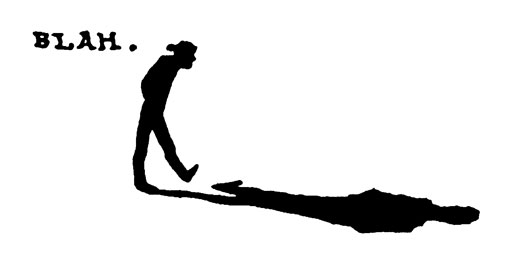
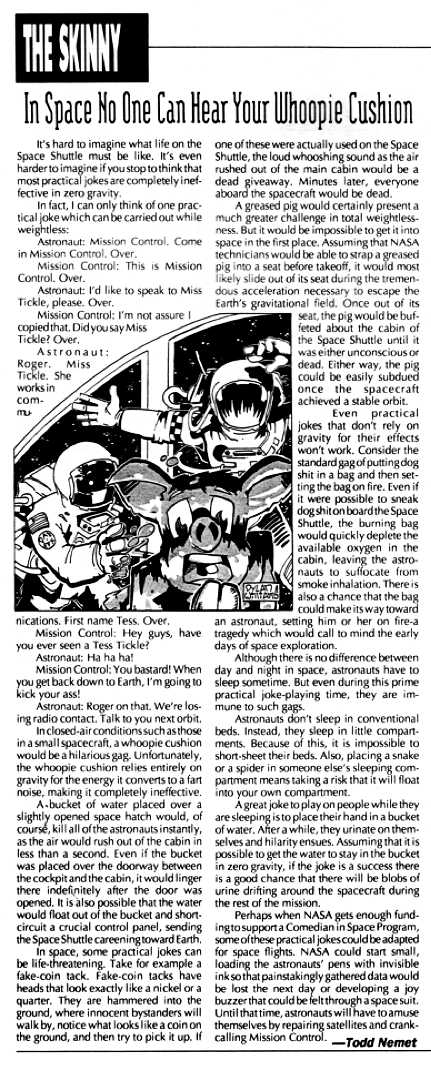
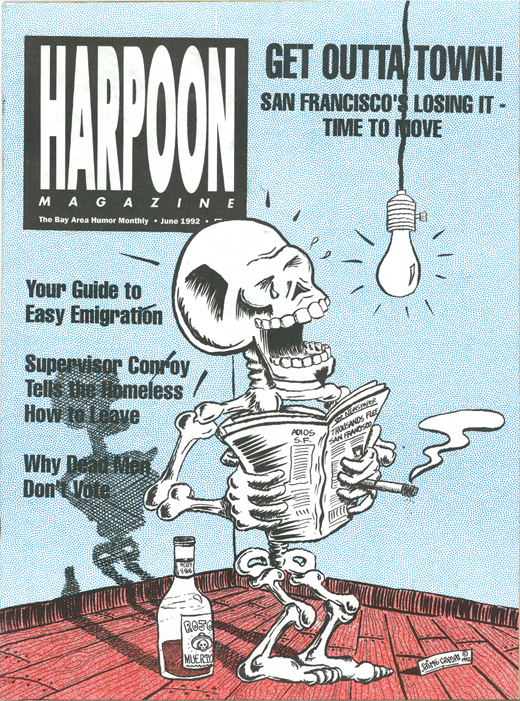
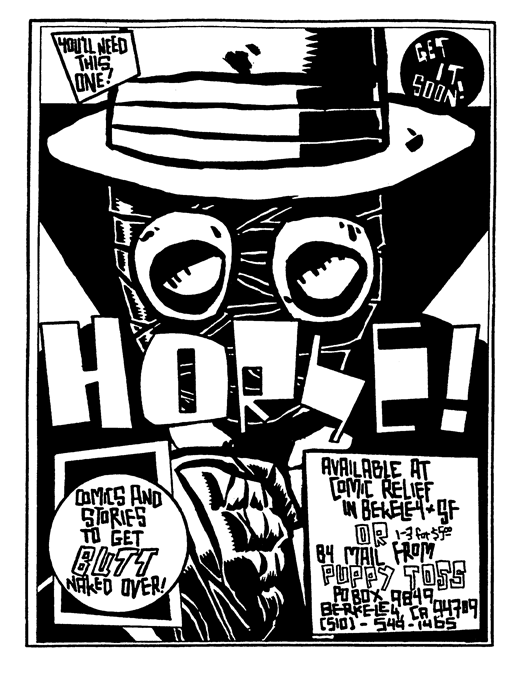
 Jeff: What's the story with the catalog and what's it called?
Jeff: What's the story with the catalog and what's it called?
 Jeff: Tell me about Forbidden Grampers.
Jeff: Tell me about Forbidden Grampers.

